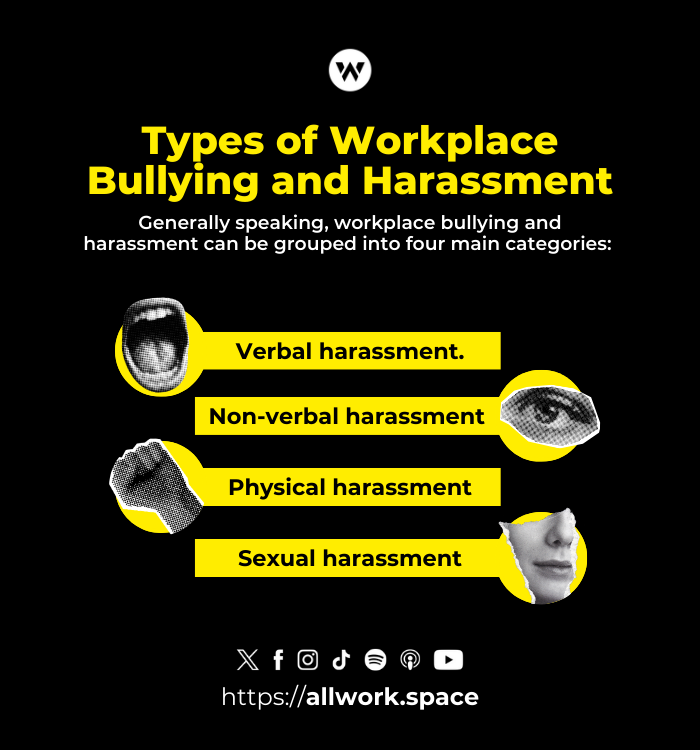- Workplace bullying, according to the Workplace Bullying Institute, is repeated, health-harming mistreatment by one or more employees.
- Workplace bullying and harassment can happen in both in-person or remote workplaces, affecting the productivity and mental health of workers.
- Proactive measures like nurturing a strong company culture and having clear policies and reporting systems are key in preventing and addressing workplace harassment, bullying, and violence.
In the dynamic landscape of the modern workplace, workplace bullying and harassment remain a constant challenge for workers. A 2021 survey by the Workplace Bullying Institute found that 30% of adult Americans are bullied at work; the same survey also found that 43% of remote workers are bullied at work.
The increase in diverse settings for work interactions has led to new and different types of toxic workplace behaviors. While the settings may be different, the consequences of bullying and harassment remain the same:
- Productivity losses
- Negative impact to mental health
- Increased levels of burnout
- Increased levels of stress, anxiety, or PTSD
- Loss of professional networks and professional growth
- Economical impact from legal action
Navigating these situations is not easy, and understanding what is happening, why, and the different types of solutions available can help workers effectively navigate workplace bullying and harassment, while also minimizing personal repercussions and impact.
Toxic Workplaces: Breeding Grounds for Workplace Bullying
Toxic workplaces are mostly characterized by infighting, intimidation, and gossip. They rarely provide a safe space for employees to voice their concerns and address problems proactively; rather, they foster an environment of negativity, competition, and hostility. As a result, bullying and harassment thrive in toxic workplaces, often going unnoticed or unpunished by leadership.
Anatomy of Toxic Workplaces
Some key factors or dynamics that create or contribute to toxic workplaces include:
- Poor leadership: Especially when leaders micromanage employees, play favorites, or actively pit employees against each other.
- Lack of communication: If there is no clear communication — about roles, responsibilities, expectations, or clear guidance on how to engage and interact among peers, then misunderstandings and conflicts are likely to arise.
- Intense workloads and pressure: If workloads are hard to manage, there are unrealistic expectations, and employees are expected or pressured to be always on, then stress, negativity, and competition are likely to increase.
- Gossip: When leaders and colleagues engage in gossip or become used to criticizing colleagues behind their backs, trust is broken and opens the door for bullying and other types of detrimental workplace behaviors.
From Toxicity to Violence: Addressing Workplace Harassment before it Escalates
Being aware of toxic workplace traits and common features is an important first step in addressing workplace violence before it even happens. Unfortunately, many professionals have been on the receiving end of bullying, harassment, and violence that stems from unaddressed toxic behavior in the workplace.
To successfully navigate such situations, it is important to first understand the spectrum of workplace harassment; especially considering that violence, bullying, and harassment can be physical, verbal, and include very subtle behavior patterns that create hostile work environments.
Types of Workplace Bullying and Harassment

Workplace harassment and bullying are different things, however, at their core, both patterns of behavior are rooted in mistreating others and harming their health — mental, physical, or emotional. The perpetrators of bullying and harassment can be supervisors, colleagues, subordinates, and/or clients. Both bullying and harassment can be experienced in in-person, hybrid, or fully-remote work settings.
Generally speaking, workplace bullying and harassment can be grouped into four main categories:
1.Verbal harassment
Verbal harassment or bullying can include the following behaviors: inappropriate comments, slurs, jokes, use of offensive language, threats, and negative remarks about a person and their individual traits or qualities.
2.Non-verbal harassment
Non-verbal harassment is characterized by actions and body language that is used to intimidate, scare, or shame people. This type of bullying includes unwanted gestures, invasion of personal space, staring, online intimidation, and stalking.
3.Physical harassment
Physical harassment refers to any type of unwelcome and non-consensual physical contact. It also includes acts of violence. This type of behavior also includes harming and damaging a person’s property. Physical bullying and harassment is commonly exhibited by pushing, shoving, hitting, punching, slapping, or tripping.
4.Sexual harassment
There are many types of sexual harassment and bullying. Typically, sexual harassment includes verbal, non-verbal, and physical behavior; some of the most common forms and types of sexual harassment in the workplace include: inappropriate and non-consesual touching; sexual remarks, jokes, comments, or requests; sending unsolicited sexual photos or content; indecent exposure; and sexual assault.
Addressing Workplace Bullying and Harassment for Organizations
The best action organizations can take to address workplace bullying and harassment is to take proactive steps to build a culture of respect in order to prevent these issues from arising in the first place. Company policies can play a big role in preventing toxic behavior that can escalate to more serious cases of bullying, harassment, and workplace violence. Here are three key actions companies need to take.
1.Build a Strong Workplace Culture
An organization’s culture is one of the most important pieces of the puzzle when it comes to preventing and addressing workplace bullying, harassment, or violence. Culture can play a major role in whether or not concerning behavior happens and whether or not employees feel safe enough to report it.
In her article “Demystifying Workplace Culture,” Angela R. Howard argues that a strong workplace culture is rooted in creating shared meaning around core values. Doing so will shape and influence the way employees treat each other, customers, and partners. More importantly, the shared meaning will make it easier for people to identify behaviors that are undesirable and in misalignment with the culture and value-system of the company.
When it comes to sexual harassment and bullying in the workplace, having a strong culture rooted in shared values means that physical, verbal, sexual, and non-verbal attacks to others will not be tolared, will be punished, and will be properly addressed.
2.Have Reporting and Investigating Mechanisms in Place
Having clear and secure mechanisms for employees to report any concerning workplace behavior is key in successfully addressing and navigating workplace bullying and harassment. What types of reporting mechanisms an organization sets up will be influenced by things like: company size, geographic location — local laws and regulations may stipulate or require specific reporting systems — and whether the company is publicly or privately held.
There are various levels of reporting mechanisms, some more formal than others, and individual company policies will dictate which mechanism to use for specific circumstances. Some common workplace harassment reporting mechanisms include:
- Direct complaints to managers
- Direct complaints to Human Resources
- Anonymous forms and systems
- Whistleblowing portals
For these mechanisms to truly work, it is important that companies also set up investigating mechanisms and procedures for any formal complaints that are made.
3.Raise Awareness
For professionals to report concerning behavior, it is important that they first know what to look out for. In this sense, organizations can raise awareness regarding workplace harassment, bullying, or violence via training sessions, workshops, and regular conversations.
Many organizations also have specific policies and handbooks about the topic. Ensuring these documents are regularly reviewed and updated is important; this is especially true for remote-first companies, as virtual platforms change quickly and new behaviors are easier to emerge and harder to detect if people are not aware of what to look out for.
Addressing Workplace Bullying and Harassment for Employees
There are various resources and support systems available for those experiencing workplace mistreatment in the form of bullying, harassment, or violence. Some of these resources will be dictated by local, regional, or federal regulations. Employees experiencing workplace harassment should familiarize themselves with the different legal safeguards applicable to them.
In the U.S., federal law protects people who are discriminated against or harassed at work, especially if they are part of a protected group. Title VII of the Civil Rights Act of 1964 prohibits workplace discrimination based on race, color, religion, sex, and national origin; it also addressed sexual harassment in the workplace.
If you are interested in pursuing legal action for workplace harassment or violence, you can file a charge with the EEOC. Keep in mind that there are specific time limits to filing a charge.
In addition to legal safeguards, the following ways to access resources and support systems can help professionals successfully navigate and address workplace bullying, harassment, or violence.
1.Contact the Right Person, Department, or Organization
If you are experiencing any sort of mistreatment, it is important that you address it via a formal channel or platform. Consider reaching out to your manager, human resources representative, or trade union or employee assistance organization. This is a good first step, and the people you talk to can help guide the next steps to find a resolution.
2.Consider Counseling or External Support
Workplace mistreatment often leads to mental health struggles and other issues that can affect life outside of work. For this reason, one of the best resources is to have an external support system that can help you process your experience and provide actionable tips and steps to protect yourself and navigate challenges effectively.
Some support systems that can help in these situations include:
- Workplace advocacy groups that provide resources, advice, and support
- Professional mental health counseling and therapy, these sessions can provide support and coping strategies
- Digital platforms and forums where you can connect with others who share your experience and can provide real-life examples of how they navigated workplace harassment, bullying, or violence.
3.Bystander Intervention
If you are not experiencing workplace harassment directly but have witnessed a colleague bullying or harassing someone, you can also take action to address this behavior. You can do this by speaking up, either by calling out the behavior as it is taking place, filing a formal complaint, or reporting the mistreatment to management, leadership, HR, or external support organizations.
Conclusion
Workplace harassment and bullying are, unfortunately, issues that continue to plague the world of work. Addressing workplace mistreatment requires a multifaceted approach that should start by having guideposts in place to prevent any sort of abuse or harassment in the first place.
Building a strong work culture, rooted in shared values, is key to preventing toxic behavior and, more importantly, to stop that behavior from escalating and transforming into workplace bullying, harassment, or abuse. Beyond that, companies need to have clear policies and reporting mechanisms available for employees, and they must take action and conduct thorough investigations when reports are made to support employees and protect themselves against liability.

 Dr. Gleb Tsipursky – The Office Whisperer
Dr. Gleb Tsipursky – The Office Whisperer Cat Johnson – Coworking Marketing Maven
Cat Johnson – Coworking Marketing Maven Angela Howard – Culture Expert
Angela Howard – Culture Expert Drew Jones – Design & Innovation
Drew Jones – Design & Innovation Andrea Pirrotti-Dranchak – Competitive Advantage
Andrea Pirrotti-Dranchak – Competitive Advantage Jonathan Price – CRE & Flex Expert
Jonathan Price – CRE & Flex Expert Jeremy Fennema – Tech Innovation Alchemist
Jeremy Fennema – Tech Innovation Alchemist






